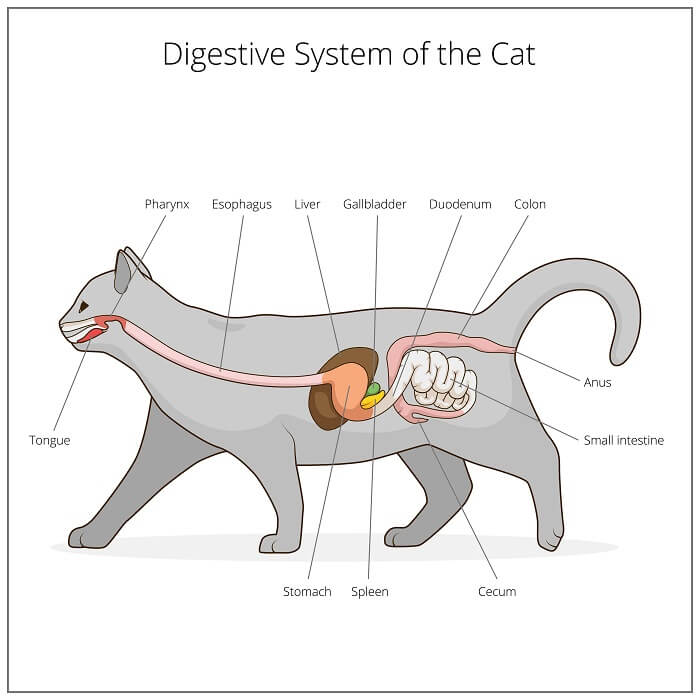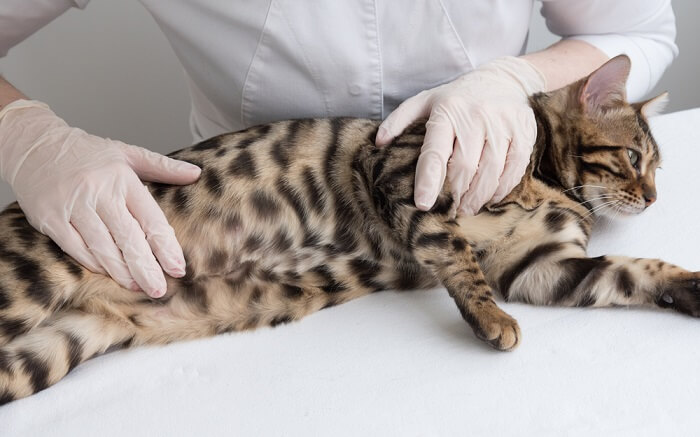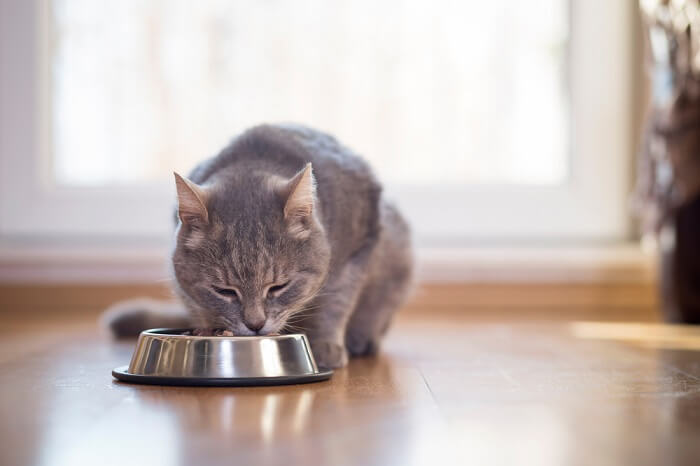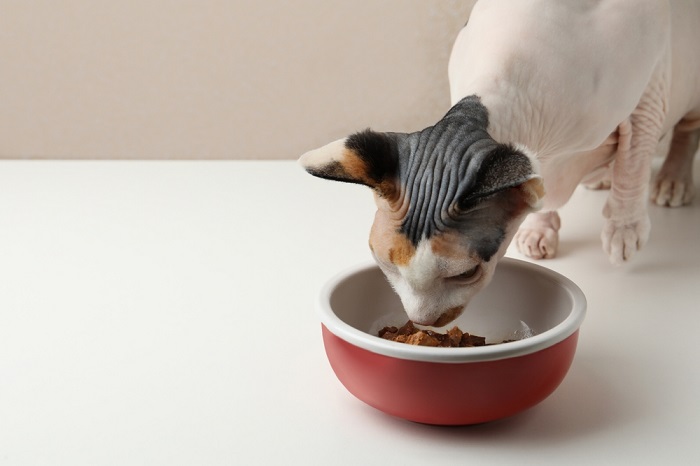
The digestive system is an important part of a cat’s body, with a central role in the cat’s health and wellbeing. This article aims to summarise the details of the digestive system, along with a brief account of the main digestive disorders that may adversely affect a cat’s health.
Anatomy of the Digestive Tract in Cats

The easiest way to understand the digestive tract is to follow the passage of food as it passes through the cat.
- The mouth is used to pick up food, breaking down larger pieces into smaller chunks by chewing with the teeth, and starting the digestive process through the amylase enzyme which is present in the saliva. The chewed food is then swallowed, passing through the pharynx at the back of the throat.
- The gullet (esophagus) then passes the food from the mouth down to the stomach. The esophagus does not actively play a role in digesting the food, but it’s an important connector, and there can be serious consequences if it fails to function normally.
- The stomach is the main receptacle for food that has been eaten: this has a large volume, and gastric secretions include juices to moisten and dilute the food, and acids that help to break food down, as well as some enzymes. The food leaves the stomach via a valve-like sphincter called the pylorus.
- The small intestines are the next part of the system: this is the area where most of the digestion and absorption of nutrients takes place. The pancreas produces a range of enzymes that digest carbohydrates, proteins and fats, so that they are transformed into smaller units (such as amino acids) that can be absorbed through the intestinal wall. The liver and gall bladder produce emulsifier-type agents that help to digest fats and fat-based products. Some metabolic products are excreted via this system, into the digestive tract and ultimately in the feces.
- The large intestine follows the small intestine: this is the area where fluid is resorbed from the liquid-consistency of the small intestinal contents, creating a more solid type of substance which ultimately becomes the feces that is passed to the outside world via the rectum and anus.
- The liver, gall bladder and pancreas are organs which are part of the digestive system, playing an important role in the production and dissemination of digestive enzymes.
Signs of Disorders

Any one of the areas of the digestive tract listed above may stop functioning normally, leading to signs of illness. The signs noticed will depend on the area affected:
- The mouth: disease in the mouth may cause inappetence, pain on eating, hypersalivation (drooling) or holding of the head to one side when eating.
- The gullet (esophagus): disease of this area may lead to inappetence, regurgitation, drooling, as well as generalised unwellness, fever and dullness (e.g. if there is damage to the lining of the esophagus).
The rest of the digestive tract is referred to as the gastrointestinal tract or GI tract.
- The stomach: the main sign is vomiting or regurgitation, as well as drooling, inappetence, and dullness.
- The small intestines: when the small intestines (including the duodenum, which is in the upper small intestine) stop working properly, the signs generally involve the impact of lack of proper digestion of the food, including flatulence, abdominal pain, diarrhea, blood in the feces, inappetence, and in the longer term, weight loss.
- The large intestine: again, diarrhea, blood in the feces, and constipation, with straining (tenesmus), or alternatively, accidents around the house may be seen.
- Rectum and anus: again, constipation, with straining (tenesmus), licking around the anus, rubbing the bottom on the ground, may all be seen when these areas are diseased.
Examination

Modern veterinary medicine has a much better understanding of a cat’s digestive system and your trusted DVM veterinarian will carry out a full assessment of your troubled cat.
The science of veterinary medicine now has a detailed understanding of the workings of the digestive tract. If your cat has signs that suggest a digestive disorder, your DVM veterinarian will carry out a full assessment of your cat.
An investigation starts by your veterinarian taking a detailed history, including aspects like what your cat is eating, their body weight, the nature and frequency of defecation, and the presence of any signs such as vomiting.
Next, the physical examination of your cat will start with an inspection of the mouth and teeth, careful palpation of the abdomen, listening to the chest and abdomen with the stethoscope, and an inspection of the anal area.
Occasionally, a digital internal examination may be needed, or the nature of the trace of feces on the thermometer may be inspected after the temperature has been taken.
After this, some type of investigation with further tests may be recommended. This may start with a minimum database of urine tests, as well as blood biochemistry (including electrolytes) and total blood count. Specialised blood tests including viral tests for FeLV and FIV may be suggested.
Diagnostic imaging such as ultrasound and radiography (x-rays) may be needed to visualise the internal workings of the digestive tract. Advanced imaging such as CT or MRI scans are occasionally needed. Finally, endoscopy may be indicated if direct visualisation and possibly a biopsy of the mucosa that lines the digestive tract is needed.
Diseases of the Digestive Tract

A long list of diseases can affect the digestive system.
- Infectious diseases include viral infections such as Feline Infectious Enteritis, Feline Coronavirus (FIP), Feline leukemia (FeLV), Feline Immunodeficiency Virus (FIV), and others. Microorganisms that can cause disease include bacteria like salmonella, Campylobacter, and many others. Parasites include Giardia, other protozoal infections and a range of worms.
- Non-infectious diseases include toxins that irritate the digestive tract (eg some garden plants, some human medications), obstructing foreign objects (e.g. hairball), intussusception (the intestinal tract folding in on itself), neoplasia (tumors of any part of the digestive tract), perforation of any part of the digestive tract, food allergy or inflammatory bowel disease (IBD), pancreatic exocrine insufficiency (lack of production of enzymes by the pancreas), the impact of other organ failure on the digestion (liver failure, kidney disease), diseases affecting the immune system, and many other possible conditions.
Treatments

A bland, easy-to-digest diet is the first step and it proves to be helpful for most disorders.
Treatment of digestive disorders depend entirely on the underlying cause of the digestive disorder. Each specific condition needs a different specific treatment.
- In general, a bland, easy to digest diet is helpful for most disorders. Commercial so-called “digestive diets” are an example of these.
- Hydration is important: cats with vomiting and/or diarrhoea, or constipation, are often dehydrated, and intravenous (iv) fluids play an important part in their recovery.
- Antibiotics, anti-inflammatory medication, digestive enzymes, anti-parasite medications, may all be needed, depending on the underlying disease.
Prevention / How To Keep Your Cat’s Digestive System Healthy?

It makes sense to take steps to promote optimal digestive health rather than waiting until there is a disease issue before taking action,
- Choose a high quality, highly digestible diet.
- Cats are obligate carnivores, but this does not mean that they need a meat-only diet. It is important that you choose a diet that is labelled as “complete”, so that you can be sure that your cat is obtaining all of the necessary nutrients from their food.
- If you are changing to a new diet for your cat, you should introduce this gradually, over 3 – 4 days, to allow their digestive system to adapt to it. Sudden changes are prone to causing digestive upsets.
- Offer fresh water at all times (eg using a cat fountain) to ensure optimal hydration.
- A regular anti-parasite regime is part of general good health care for a cat.
- Maintain good general overall health, with once yearly health checks by your veterinarian, including vaccinations as needed to protect your cat against viral infections.
Conclusion

The digestive tract is a key part of the cat’s bodily system, and good digestive health is a key part of overall good health in all cats.
Frequently Asked Questions:
How long does it take for food to pass through a cat's digestive system?
It normally takes 10 - 24 hours for food to move from the mouth to being passed from the anus at the other end of the digestive tract. However it is possible that some objects can linger for much longer, taking weeks or even months to be passed.
How does a cat's digestive system work?
Essentially, food is eaten, passes into the stomach, is digested by acids and enzymes in the stomach and small intestines, nutrients are absorbed in the small and large intestines, water is resorbed from the intestinal contents in the large intestines, and firm feces is passed via the anus.
How do I know if my cat has stomach problems?
The main sign of stomach problems is vomiting or inappetence, while the main sign of problems in the intestines is vomiting, diarrhea or inappetence. Your cat may also be dull and less active than normal. You may also notice signs like borbyrygmae (bubbling, gurgling noises) and flatulence.
How do cats digest food?
Cats eat food, breaking it down initially by chewing, and it then passes into the stomach after being swallowed. Food is then partially digested by acids and enzymes in the stomach before passing to the small intestines where enzymes from the pancreas and liver continue the digestive process. The resulting broken-down nutrients are then absorbed via the small and large intestines.








my cat chewed and swallowed about 2 ” of shoe lace last night.She ate her wet food this morning. Is it possible for her to pass this on her own within 24 hrs, or does she need to go to the vet?
Our 11 year old fixed male cat is eating more than ever. About twice to three times as much. He has lost 4 pounds. He doesn’t act like anything is wrong except that he doesn’t groom himself well any more. He doesn’t vomit and his poo is a light tan and almost solid like a regular cat. We have to give his bottom, back legs and tail a bath or he smells and it looks like he has water on his hair. The smell doesn’t smell like poo. We took him to the vet and she said she thought his intestines are not working. Any idea or help?
Please read my article on hyperthyroidism here https://cats.com/hyperthyroidism-in-cats
I’d strongly suggest that you go back to your veterinarian to discuss this again. The aim is always to find a diagnosis and this usually involves tests like blood and urine samples. Has this been done yet?
Our cat, Hannible, meows all the time like he is not getting enough to eat. He likes “people” chicken and a few other cans of wet cat food, Temptations cat treats and that is it. When we feed him, he licks a little gravy off the food and then leave just to come back a little while later meowing for a new can of food ((he really doesn’t like “left overs.” He vomits every few days and drinks a lot of water. There are no issues with his litter box usage. He is a senior cat and has been an inside cat all of his life.
We love him dearly and I am worried he may be very sick.
Hey there, I’m sorry you’re so worried about Hannible’s behavior! I really can’t give you anything that you wouldn’t be able to learn from a vet visit and senior labs. It sounds like he might have some issues going on (maybe hyperthyroidism and/or kidney disease) between the constant meowing, vomiting, and heavy water drinking, but as a non-vet who hasn’t seen him in person, I can’t tell you what it is. Fortunately, there are a lot of ways that you can help senior kitties live well, even if it does turn out that something is wrong. Wishing you all the best.